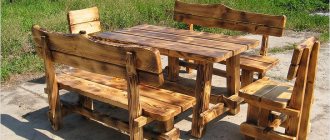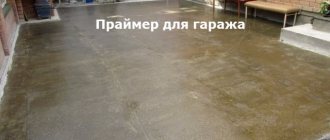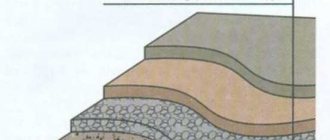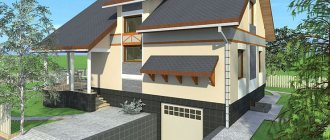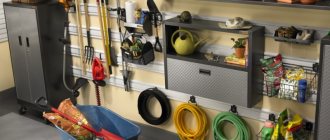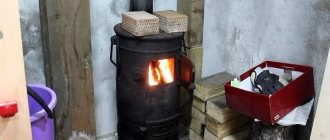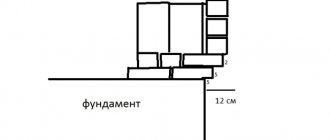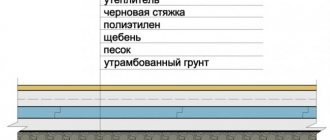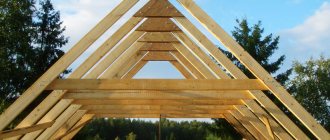Construction of an inspection pit in a garage is a responsible undertaking. It is necessary to correctly mark the site, and then begin excavation work. When the pit is dug and the pit itself is equipped, there is also a lot of work to do. You will have to take care of waterproofing and thermal insulation. In addition, it is important to immediately think about how to cover the hole in the garage. Then additional space will appear in the room, and the pit itself will be protected from various negative influences from the outside.
Today we will pay attention to the key points in arranging a viewing hole. We will devote most of our time to the issue of making a cover for the inspection hole. It must be sufficiently reliable, durable and functional.
Rules for constructing a repair pit
Compliance with rules and standards, even on such a structure as an inspection pit, is regulated by the standards of the Russian Federation. GOST dimensions of the inspection pit in the garage are strict only if you are using it to service commercial vehicles: taxis, passenger cargo cars, and others. Or they opened a private workshop (STO). But if only a personal car is parked in the pit, then no registration is required.
The dimensions of the inspection hole in the garage also determine this. Width - from 800 mm and more, taking into account the distance between the wheels. If you make it narrow, it will become more difficult for you to turn, and you also need to remove or install the nodes.
The length of the pit should be less than the largest dimension of a personal car. Drivers don’t think about the size of the body, so let’s recall the length of some cars.
Excluding mini-models, all of them are longer than four meters:
- GAZ-310105 Volga and its 24th model - 4,921 and 4,735 mm;
- Toyota Camry – 4760;
- rare M-21 – 4810;
- Muscovites – 2141 and “Svyatogor” – 4350;
- VAZ classic - 4145.
For a pit, add about another meter to the length of the car. This will allow you to quickly cope with repairs without rolling the car back and forth in a short niche. The average length of the repair part is approximately 5100 mm.
You also need a convenient descent at the beginning of the pit along the steps, if the “shell” frame allows it - this is another 1500 - 1700. If there is not enough garage space for this, then stop at the repair length and go down into the pit along the stairs.
What state standards and regulations exist for inspection pits?
Regulatory documents regarding the equipment of the inspection pit apply exclusively to enterprises involved in the inspection of automotive equipment. They assume that this structure is part of the technical base, and therefore is subject to appropriate registration, in full compliance with existing GOSTs.
There are only a few such documents. The regulations are more concerned with the rules regarding lighting and ventilation schemes, safety, rather than dimensions. If the structure is not equipped for the purpose of conducting commercial activities, compliance with the requirements of these documents is not required. Otherwise, it is necessary to study the relevant regulatory framework.
The absence of the need to register a garage with an inspection pit does not mean that it can be erected in any order. There are certain standards on which the safety and ease of operation of the structure depends. An important factor is deciding which vehicles are supposed to be serviced - cars and/or trucks. This determines the dimensions of the future structure.
Where to start making a viewing hole
Any structure always begins with calculations; before starting to dig a pit, it is necessary to determine in advance:
- dimensions;
- the place where the pit will be located;
- materials used (brick or concrete).
It should be said that it is easier to make a SA when there is no garage, and it is only in the project, especially in cases where the groundwater is located at a depth higher underground than 2.5 m, since in this case drainage work is required. If the waters lie too high under the finished garage, you may have to abandon the inspection hole, since drainage will be very problematic.
So, first we decide on the sizes:
- length - usually taken about one meter longer than a standard car. If the garage is intended for the repair and maintenance of passenger cars, a typical size of 4.5 m is assumed, which means the length of the pit should be approximately 5.5 meters;
- width - should not be too small, it is necessary that an adult can fit comfortably in the vehicle; it cannot be wide, otherwise not every passenger car will be able to drive into the pit without the risk of falling down, moving off the track. Usually the width is 0.75-0.8 m, this is the most typical size;
- depth - calculated taking into account the height of an adult man (170-180 cm) plus a margin for convenient inspection and repair (15-20 cm), typical pit depth is 1.85-2.00 m.
In general, builders always try to dig the SJ a little deeper - reducing the depth is quite easy with the help of stands and laying an additional layer of material at the bottom. But it is difficult to deepen the hole, since you have to destroy the bottom layer, re-lay the floor, and carry out hydro- and thermal insulation.
You can make a pit of various designs with your own hands:
- ordinary, with a floor and reinforced walls;
- with niches in which you can lay out tools and small parts removed from the machine;
- with a cellar for household or household needs.
The pit is always dug with a reserve not only in depth, but also in width and height, since it is necessary to expect that all surfaces will be reinforced with concrete or brick, waterproofing will have to be done, ideally it would be nice to provide thermal insulation.
Recommended sizes
Recommended inspection pit dimensions
The internal dimensions of the pit are determined by the dimensions of the machine. In addition to its length and width, the height of the driver who will be doing the repair work also matters. The width of the pit for a passenger car is at least 0.8 m, and the depth should be 0.1-0.2 m greater than the owner’s height. In this case, he will not have to take uncomfortable positions to carry out repairs. The length of the pit should be at least a meter longer than the car itself. This reserve is left to create the stairs. For a standard passenger car, it will be 5 m. When the garage is not long, but has sufficient width, the entrance to the pit can be equipped from the side.
Construction parameters (dimensions of the excavated pit) will be slightly larger than the internal ones. Part of this space will be used to arrange the pit. A cushion with a waterproofing layer is created at the bottom, which is then filled with screed. Wall parts can be poured into formwork or assembled from block materials. All this requires space that is not included in the final internal dimensions of the structure.
The width of the excavated pit is equal to the sum of the final width of the pit, the thickness of the walls and a margin of 0.3 m. The length is calculated in the same way. The depth will be equal to the sum of the heights of the pillow and the tightening layer, the height of the owner and a margin of 0.1-0.2 m.
Preparation
First of all, you will need to carry out comprehensive preparatory work. Now we will highlight all the most important points.
Groundwater
One risk factor is of great importance - the level of groundwater rise. The final success of the construction of the inspection pit largely depends on this. In some cases, it is necessary to abandon the construction of such a pit or cellar. You need to be prepared in advance for the fact that the water level will be critical.
Unfortunately, in some settlements there are no specialized geological services at all, where appropriate surveys are carried out. But you can independently determine the level of groundwater rise with fairly high accuracy. This is done as follows. You need to dig a hole 2.5 meters deep. Watch to what level the water rises. When the worst forecasts are confirmed, that is, the waters lie too close to ground level, it is better to abandon the construction of a viewing hole. Of course, purely theoretically, it is possible to ensure waterproofing even in such a situation, but then the pit will resemble more of a bunker, great effort and investment in construction will be required, and the danger of flooding will still remain.
Another option that will help cope with the natural risk factor is to arrange drainage. It happens that a car enthusiast works on his car professionally, he needs an inspection hole, but there is no opportunity to choose another area. In this case, high-quality drainage of groundwater should be done. A special drainage well is dug outside the garage, where the water is drained. But such work is labor-intensive and requires significant investments.
We correctly determine the dimensions of the inspection hole
It is very important to immediately accurately determine the optimal parameters of the inspection hole. It shouldn’t be too big, but it’s also inconvenient to work in tight spaces.
Everything must be selected correctly, of course, in accordance with the dimensions of the car.
Let us dwell on the methods for determining key parameters.
- Pit length. Consider the vehicle parameters. Typically, the standard length of an inspection pit for a passenger car is approximately 4-5 meters. To arrange a convenient descent with an extension or monolithic ladder, you need to add another meter. These are good parameters that are aimed at comfortable, rational use of the inspection pit. You will no longer need to regularly move the car during repair work, as happens if the hole is too small or short.
- Width. Here the distance between the wheels of the car plays a key role for you. The standard parameter for modern passenger cars is a pit with a width of 75-80 cm. This width will be quite sufficient, and it will not be too large.
- Depth. Everything here is strictly individual. Of course, they work standing in the inspection pit. Some dig shallow holes so as not to provoke pressure and flow of groundwater, but it is inconvenient to work while sitting on a stool. It is better to make a good deep inspection hole. Approximately 15 cm is added to the height of the car enthusiast. When any doubts arise about the depth (for example, when several people of different heights are planned to work in the pit), of course, it is better to make it larger. After all, if necessary, you can simply make a small platform under your feet.
When the parameters are determined, you need to make a drawing and write down all the exact dimensions on it. Then this diagram is transferred to the construction site, digging a pit.
Construction methods
The construction process will largely depend on the method of arranging the inspection pit. The best option is to lay the foundation right away, even at the stage of constructing the strip foundation and basement of the garage. In this case, the pit is also dug by an excavator. At the same time, work is underway to waterproof, ventilate and insulate the pit and the garage space as a whole.
But quite often you have to do construction after the garage box has been erected. Of course, then you have to dig the pit manually.
Please note one important point. You will need soil from the development, so that you can then fill the sinuses with it, as well as raise the floor level in the room
The fact is that the garage floor is made at a level higher than the road on which the car drives.
Waterproofing
There are several ways to waterproof an inspection hole in a garage. Each of them has certain advantages. For example, external waterproofing of an inspection pit is created only at the construction stage. The internal one can be mounted after creating a full inspection hole. Before work, it is better to create a full-fledged drawing, which will indicate all the materials from which the structure is made.
Protection of the inspection pit from the outside
If at the site where the garage is being built, the soil waters lie very deep, for example, below 2.5 m, waterproofing the inspection pit may not be necessary.
It is important to check the soil water level in the spring. If even during a flood it does not rise above the specified indicator, you don’t have to worry about waterproofing
However, the geological situation may change. In a dry place, water can easily appear after a few years. If there is already an inspection hole, it should be equipped from the inside. For this purpose, special impregnations are used. They penetrate deeply into the structure of the stone and perfectly protect the inspection hole from water penetration.
A variety of films are used for external waterproofing of inspection pits. The pit is covered with such products from one ridge to another. In this case, it is necessary to release 15 cm on each side. The panels must be laid overlapping. The joints are connected with double-sided tape. The film should adhere well to the walls. To do this, it needs to be straightened. During installation work, you need to carefully monitor the integrity of the film.
Internal waterproofing of inspection pit
A special impregnation is used as internal waterproofing of the inspection pit. This type of waterproofing is called coating. The inspection hole in the garage can be coated with a special composition for swimming pools. When using such material, a waterproof film appears on the surface of the walls, which in external parameters and characteristics resembles rubber. It is usually painted blue and is easy to clean once it hardens. When using this composition, treatment should be carried out at least 2 times.
Another option for protecting the inspection pit from water is to use a cement-based primer. It contains polymer particles that can reliably block small channels that allow moisture to pass through. When performing one of these measures, the hygroscopicity of the walls is significantly reduced. If water constantly appears in the pit, the treatment should be carried out 2 times.
Installation of a caisson in an inspection hole
To ensure that the inspection hole in the garage is reliably protected from moisture, you can make a caisson. To do this, a box is welded from metal sheets and installed in a pit. It must be treated with anti-corrosion agents. If the welds are made airtight, water will not penetrate into the pit. If there is too much water, the caisson may “float”.
To eliminate this situation, corners should be welded to the caisson, extending 1.5 m into the ground. In order not to carry out large-scale excavation work, before installing the caisson, you should hammer the corners into the ground and leave their ends outside. They are welded to the caisson after it is placed in the pit. In this case, the pit will have to be made in a large size. The advantage of this solution is that the corners will be driven into denser soil and the caisson will be held better.
There is another way to avoid raising the caisson in the inspection hole under the influence of groundwater. At a certain height it is necessary to make a hole. Through it, water will flow into the caisson as it rises. It is subsequently pumped out. Such an inspection hole can last for more than 20 years until the metal rusts.
Pit for catchment in inspection hole
If there is already a finished hole, water can still penetrate into it. Sometimes coating waterproofing does not help from this. In this case, you will have to build a drainage system. It can be located around the entire garage. You can also make a special hole in which excess moisture will collect. A pit is made in the corner of the pit. The accumulated water is subsequently pumped out of the pit with a pump. The system can work automatically. To do this, install a water level sensor in the pit.
Formwork should be made under the pit, and then concrete should be poured into it. After this, it is necessary to waterproof the pit. It is usually carried out together with waterproofing work carried out throughout the inspection pit.
With such waterproofing, it is impossible to completely get rid of dampness, so boards are laid on the floor. They can be protected from rotting using special treatment. You can buy a special impregnation for wood that comes into contact with the ground.
What do you need to know when building?
Groundwater height. If it is at a level of 2.4 m, you cannot build a hole there; the water will partially flood it. No amount of sealing, even with a steel bowl, will help - the water will lift the bowl. In constant moisture, the car will begin to rust.
In this case, weld a metal overpass in the yard near the garage. You don’t have to raise it high if you dig a hole under it, lined with bricks, even a meter deep. The level of the overpass and the pit is almost enough. Only cover it when it rains.
Let's go back to the garage. Supply electricity to the hole; it will be more difficult to repair with a flashlight in your hand. Transform 220 volts into 12 - 24 and stretch diode lighting tapes along the sides of the pit.
Wall and floor finishing
The floor must be poured with concrete after the walls have been constructed. A metal mesh or wire-tied reinforcement is pre-laid. The frame must be completely covered with mortar.
To improve the appearance of the pit, the brick walls are plastered or covered with ceramic tiles. It is important to provide niches in the walls for tools; this will ensure the convenience of working in the pit.
The floor is carefully leveled and finished in the same way. If you decide to lay tiles on the floor, non-slip materials are selected to ensure safety.
To prevent the car's wheels from accidentally sliding into the pit, wheel guards are made from a metal corner and installed taking into account the vehicle's track width.
Waterproofing and insulation
The main requirements for waterproofing materials are their cost-effectiveness and efficiency. Based on these criteria, the following options can be used:
- single-layer polymer membrane - its thickness is 2 mm, the material is durable and strong, but is high in cost. In addition, special equipment will be needed to install the membrane;
- bitumen-based materials (roofing felt or bitumen lubricant) are widely available in terms of cost, very easy to install, and their service life will be at least fifteen years;
- waterproofing lubricant - easy to apply and has a relatively low price.
The main task of insulation is to reduce the amount of electricity required to heat the garage. The insulation is glued to the walls and floor of the garage pit before final finishing.
Among the many options, it is recommended to give preference to a material that meets such characteristics as:
- long service life;
- resistance to heat loss;
- moisture resistance;
- affordable price;
- compliance with fire safety requirements.
The material used to insulate the floor of the pit must be more dense than the material used to insulate its walls.
When and how to carry out excavation work
The main difficulties with building a pit arise when the groundwater level is high. This forces access to the back of the walls to perform waterproofing. There are many reasons to start excavation work and install an inspection hole at the stage of pouring the foundation, although this, in principle, can be done at any time, even after several years of operation. Simply installing a girdling hydraulic lock may require dismantling a significant part of the floor.
Therefore, we offer you an option with a two-layer wall cladding and a waterproofing device in the intermediate layer. Otherwise, the floor will have to be dismantled 25–30 cm wider than the pit box, and upon completion of the laying of the walls, the free space must be filled with crushed and moistened clay.
If the waterproofing is installed between layers of masonry, the internal profile of the pit is cut out in the floor, plus 50 mm on each side. Afterwards, the pit expands by 25 cm in each direction, thus the hard floor covering seems to “hang” over the walls and is preserved. Of course, if the floor is made of piece materials like bricks or paving slabs, it is much easier to re-lay the section of floor around the hole, but in the case of asphalt or concrete screed, it is recommended to preserve the covering.
The foundation pit is dug in the same way for both a garage under construction and one in use. With a net pit width of 80–85 cm, the pit will be 125–135 cm, the length corresponds to the size of the car, plus an additional one and a half meters for the entrance part. The depth of the pit is selected according to your own height plus 35–40 cm.
An extremely useful element of the inspection pit is the rotating part on the side, where the steps for descent are located. There is an opinion that the L-shaped pit should have been originally: a more convenient entrance and the ability to reduce the length of the pit in a small garage.
DIY concrete inspection pit
This is one of the most popular arrangement options. The process is described in detail in the video below.
When choosing dimensions for a pit, it is necessary to take into account the planned thickness of the walls and increase the depth of the inspection hole by the thickness of the sand and gravel cushion.
The pit expands slightly (or quite strongly, with an angle of up to 30 degrees for loose soil).
After obtaining a hole of the required dimensions in loose soil, it makes sense to coat the walls with clay - this will prevent them from crumbling during further work.
6...10 cm of crushed stone and the same amount of sand are poured onto the leveled bottom, the layers are compacted manually or using a mechanical tamper. Next, the primary layer of concrete is poured - “milk” to hold the compacted pad together. Waterproofing will be carried out immediately. The photo shows two layers - a regular plastic film on the bottom and a more solid one on the bottom and the entire height of the walls with an overlap on the garage floor. Joints and corners MUST be glued and overlapped.
After this, the reinforcing mesh is laid and the base layer is poured.
For concreting the walls, formwork will be required. Since the inner surface of the pit is important, the formwork is installed from the inside, having previously secured a reinforcing mesh to the walls of the pit.
Before concreting, it is necessary to install exhaust and supply ventilation pipes.
Boxes with power supply cables enclosed in a corrugated sleeve are also installed.
After installing the formwork, concreting is carried out.
It is advisable to concrete the entire floor in the garage at the same time - this will reduce the time for arrangement.
After the concrete reaches its design strength (at least 50...60%), you can remove the formwork, check the free passage of air into the ventilation pipes, the position and functionality of the electrical wiring.
Sockets and lamps are installed in the niches.
The walls are plastered from the inside and painted (optional). Install the boardwalk onto the pit.
Please note: board covers are made from separate parts. This makes it more convenient to lift them as needed and easier to replace damaged parts
Wooden parts of the inspection pit must be treated with an antiseptic.
Safety precautions
Repair work related to lifting passenger vehicles to a height is carried out in compliance with safety regulations. Lifting the car using a jack is carried out with a preliminary inspection of the device for the absence of mechanical damage and the ability to withstand the weight of the car.
When using non-standard methods of lifting a passenger vehicle, observe the following conditions:
- carry out work on a flat surface when placing the machine for long-term repairs;
- choose places with dense, motionless soil;
- use stands and racks made of durable material - metal, stone, thick wood;
- lift the car using reliable devices or with the involvement of at least 4 people;
- lift the underbody in the area of the side members so as not to cause deformation of the structure;
- when installing the bottom on the racks, fix the elements together to eliminate the risk of the car sliding off;
- ensure a stable position of the vehicle. Hang the body on 2 or 4 racks to achieve balance;
- install homemade shoes or wheel chocks under the wheel elements;
- After fixing the machine, apply the handbrake;
- Use several jacks to lift the vehicle. Lend devices for temporary use to ensure a safe position of the body on the racks;
- keep your mobile phone handy. During repairs, you should be able to call your family or emergency services if the car suddenly falls off the makeshift rack;
- Place the supports on a flat, solid surface. Place a metal sheet, wide board or thick plywood under the structure;
- Place a blanket under the workplace, use special clothing and protective equipment when carrying out repair work.
Important! Distribute the weight of the machine evenly on the supports. Skewing the mass to one side can upset the balance. A thoughtful arrangement of the car on 2 or 4 racks will eliminate the occurrence of traumatic situations or mechanical damage.
There are many ways to lift a car easily and safely without a jack. The passenger car is lifted by a crane, driven onto a mini-overpass, placed on supports made of rims, boards, bricks, or placed on a curb stone. It is important to follow safety precautions when lifting heavy loads to heights.
Underground ventilation
In the repair trench, due to the temperature difference, increased humidity occurs and condensation forms and settles on the bottom of the car. To avoid this unpleasant phenomenon, the inspection pit in the garage must have good ventilation. The exhaust duct is made of asbestos-cement or plastic sewer pipe embedded in the crushed stone preparation of the floor. This pipe must be connected by a transition elbow to a vertical exhaust riser. The hoods from under the ceiling of the garage box and trench must be independent. If you combine them into one, the efficiency of ventilation of the technical underground will sharply decrease.
Kitchen design 12 sq. m. with access to the balcony
Any housewife will be pleased with the additional space. The balcony is used as an extension of the kitchen. There is a dining table in it. If you can’t turn your idea into reality, you need to take care of decorating the exit using draperies and glass doors.
Kitchen design 12 sq. m. with a balcony are chosen after studying photos of projects. If you expand the useful space, then there will be more sunlight. To develop an original version, the partition is removed. This is not always feasible for technical reasons, so property owners require official permission for such redevelopment.
How to make a vegetable pit in the garage
If the garage already has an inspection hole, the cellar is made separately, at the other end of the room or next to it, usually it is located at a short distance from the wall, about half a meter, and unlike the SY, it has slightly different dimensions:
- length – 2.5-3 m;
- width – 2-2.5 m;
- depth - approximately 1.7 m.
The dimensions of the cellar may differ from the above dimensions, it all depends on the size of the garage itself. This building must have a sealed hatch cover and an extension ladder (it is better to make it from wood). The cellar should provide:
- protection from moisture;
- ventilation;
- sleeping sinus.
Electricity and thermal insulation can be added to the vegetable pit as desired; before construction, it is important to consider two points:
- you need to make sure that there are no power wires, water supply or gas pipelines running under the future cellar;
- groundwater must pass below the level of the foundation of the proposed vegetable pit.
As when creating a cellar for a cellar, we also first dig a pit, then:
- sprinkle and compact a layer of crushed stone on the bottom, approximately 10-12 cm;
- lay the next layer - construction sand (about 15 cm), careful compaction is also required here;
- fill the bottom of the pit with bitumen or another similar composition, if waterproofing is necessary, with roofing felt (you can also use other similar material);
- fill it with concrete, for the strength of the structure it is advisable to reinforce it;
- let the concrete solution set well and dry, then strengthen the walls - fill them with concrete or lay them out with bricks (the latter option is the most preferable).
The standard wall thickness is one and a half bricks; for strength and better waterproofing, we coat the masonry with bitumen mortar. The walls of the pit must be very strong, because the car can be placed anywhere in the garage, and it is not advisable to leave it for storage in an inspection pit.
The ceiling in the cellar is made in the form of a vault, in order to hold the ceiling bricks during construction, they are laid out on a plank template. The upper part of the cellar can be made of concrete, the main thing is that it is durable, and the manhole is usually made in the middle. In a vegetable pit, the ceiling is often insulated; foam and expanded clay are used as materials; in order to secure the insulating layer, it is filled with hot bitumen. Glass wool, sawdust and cement are also used for insulation; thermal insulation may not be used in mild and warm climates.
In the cellar it is necessary to make shelves for food supplies and containers for storing vegetables. Shelves are usually made of boards and beams; ventilation of the room is mainly ensured through natural ventilation. Forced ventilation provides air circulation more efficiently, but also requires more significant financial costs. Typically, an electric fan is used for forced exhaust; it is mounted directly in the ventilation pipe.
Important details when arranging
The inspection pit from the inside can be filled with concrete and covered with tiles
. It is advisable that work on the arrangement of the pit take place in the warm season. It is not recommended to do this in winter. It is important to take proper care of waterproofing: the pit is characterized by a humid environment, and dampness contributes to the damage of building materials by rust and mold colonies. For those who do not want to equip the interior of the pit with their own hands, there are ready-made polymer kits. They must be installed in accordance with the instructions on the packaging.
When the pit is ready, sand is poured onto its bottom to a height of 0.15-0.2 m. It is compacted and watered. Then small crushed stone is poured to a height of 0.1 m. The walls and floor of the pit are lined with waterproofing material. Rolled roofing felt is suitable for this. If it is not available, you can use polyethylene film, but it should be no thinner than 0.2 mm. The strips are mounted on top of each other with an overlap and connected with adhesive tapes. The edges of the material extend a few centimeters beyond the pit. They can be pressed to the ground or floor with a heavy object.
Wall deformation due to insufficient floor screed width
A screed of 3-6 cm is placed at the bottom of the pit. Since serious loads do not affect the surface (as a rule, they are limited by the body weight of the car owner), there is no need to reinforce it. For the construction of walls, masonry from block materials (including bricks) is often used. The binding solution is made from sand and cement. Elements of material are laid out with a shift of half a unit.
Sometimes the walls are made of concrete poured into formwork. The latter can be made from wood, corrugated sheets or OSB boards. When assembling the formwork, it is important that it does not move apart under the weight of the poured concrete. The latter must be laid out in the structure in one go, without leaving it for another day. A lattice frame for reinforcement is laid in the middle part of the formwork space. The rods used for it should have a diameter of 0.6-0.8 cm. The gratings of nearby walls are connected with wire. The formwork can be dismantled after 7 days, but before moving on to further work, the concrete must be cured for a month. This is exactly the time it takes for him to gain strength.
The walls can be tiled, covered with paint or plaster. The good thing about tiles is that they can be easily washed off from dirt that occurs during renovation work. But the floor screed for this option should be thick enough.
Pit ventilation in the garage
The type of ventilation largely depends on the size of the garage; for fairly large garage structures, you can limit yourself to natural ventilation; for small rooms, forced ventilation is necessary. The exhaust vent is almost always made from above, near the ceiling, in the room it is covered with a metal or plastic grille, supply ventilation is installed below, no higher than 0.5 m from the floor.
They try to make the exhaust hole for natural ventilation on the leeward side; usually it is protected from rain and snow from the outside by a garage roof. Power for the electric fan is taken from the local electrical network or battery, the direction of movement of the blades is selected experimentally.
Execution options
Scheme of the inspection pit.
There are many examples of garage projects with a basement and inspection pit. Let's look at some of them:
- The cellar is deepened, the entrance is from a viewing hole. A very common option, often used in garage cooperatives.
- Separate entrance for the basement and garage box. Most often used for capital structures.
Let's look at the first option in more detail.
Project of a garage with a basement and inspection hole
It is better to plan the dimensions of the basement in accordance with the dimensions of the garage, and make the walls thicker, since they will form the foundation for the walls of the garage box. Preferred material: monolithic reinforced concrete blocks or concrete structures.
Let's look at the stages of building a garage related to the basement.
Basement floor and walls
The surface of the bitumen that has hardened at the bottom of the garage is covered with a waterproof material, for example:
- roofing felt - the material is easy to install, cheap;
- Euroruberoid is a more expensive material, it has two layers of granite topping and plastic film;
- polymer membranes - unlimited service life, the material is resistant to chemical, temperature and mechanical influences, it is necessary to attract specialists for use in construction;
- penetrating waterproofing – blocks the penetration of moisture into concrete, an advanced product;
- “liquid rubber” – a bitumen-polymer composition, is an elastic rubber-like continuous membrane.
The walls of the cellar also need to be protected from moisture with the special materials discussed above. Cover the inner surface with a layer of plaster.
Ventilation system
Arrangement of an inspection pit and basement in the garage.
The presence of a working and effective ventilation system prevents the accumulation of moisture and the appearance of dampness. Wood will not rot, and it will not be long before you see rust on metal.
There are two types of garage basement ventilation:
- Simple. Ventilation occurs naturally, by air flow - a draft. It is necessary to install two pipes - exhaust and supply. The method is cheaper and more reliable.
- Forced. Implemented in the form of fans powered from the mains.
Now you can begin building the walls of the garage box and making the roof.
Option for car repair
There are various options for inspection pits. You can find seated, standing, combined with a cellar. In the first case, work is carried out standing. In the second, they move using a seat equipped with rollers and running along guides. This saves the cost of arranging walls.
Before carrying out work, the following features must be taken into account:
Waterproofing is a mandatory design element that affects the entire room. If you refuse it, there is a possibility of turning a dry and warm garage into a damp room. In this case, the car standing above the pit will become damp and corroded. Installation of a power circuit around the perimeter of the structure. The reinforcement or table frame holds the trench walls, preventing collapse under static pressure. Additional reinforcements are installed in the wheel area. For ease of work, special niches are made in the structure
Standard dimensions are 300 x 200 x 450, respectively height, depth, length. The structure must be equipped with ventilation to eliminate the accumulation of oil and gasoline vapors. Attention should be paid to lighting. Power supply should not exceed 36 volts
If the voltage is high, there is a risk of fire. The cover for the structure is made of wood and serves to ensure safety.
Typically, such pits are slightly shifted towards one wall, leaving the other for storing auto parts and tools.
How and with what to close the inspection hole
Cover made of boards fastened together
When arranging a pit, you need to think about how to cover the pit in the garage while it is not in use. Even before arranging the wall structures (laying blocks or pouring concrete), you need to make an embedded frame. It is mounted on a board located at the same level as the garage floor or slightly higher. The raw material for the frame is a steel angle. During production, a welding machine and a circular saw with attachments suitable for the material are used.
The dimensions of the frame are selected according to the outer or inner perimeter of the walls. The corner should be positioned as required by the plane of the tire. It is fixed with dowels or anchors. Holes for fasteners will have to be made in advance. If you plan to cover the hole with a prepared canvas, the frame is turned downwards. To prevent it from rusting, before installation it is sanded with sandpaper, primed and painted.
The lid that will cover the pit can be made from different materials. Common options are designs made of a metal frame with mesh fabric and wood.
The lid can be made from edged boards like this:
- From bars with a square cross-section (with a side of at least 4 cm), logs are laid out with dimensions identical to the distance between the end walls.
- Boards are cut. Their width is selected so that the tire fits into a pre-mounted frame. The minimum thickness is 3.5 cm. They should also not be made too thick, otherwise the canvas will be difficult to lift.
- Before fixing the bars and boards, they are impregnated with an antiseptic composition and varnished.
After this, you can fasten the structural components to each other. Simple nails or self-tapping screws with zinc coating are suitable for this.
Standard sizes
There are no standard sizes that this design must comply with. Dimensions are selected based on the size of the machine and are:
the minimum width of free space is at least eight hundred millimeters
It is important to correctly calculate the distance and width of the ditch when laying the hole. The final width dimensions should be two hundred millimeters less than the vehicle track size (if we take the distance between the internal planes of the running wheels)
The width of the ditch is made three hundred millimeters larger than the final dimensions to ensure strengthening of the walls; the length is determined by the dimensions of the room where the work is performed and must exceed the corresponding dimensions of the machine by at least five hundred millimeters in each direction. Taking into account the above circumstances, this size ranges from two to six meters. It is also necessary to take into account the construction of a ladder for descending into the pit. It is performed in an attached or stepped version. The attached option will save space, but is less safe and convenient; the depth parameter depends on the height of the car owner. Initially, the pit is dug up to two meters, so that the finished height is about eighty meters or a little more. When choosing the depth, it is necessary to start from the level of groundwater.
The optimal dimensions are determined by the characteristics of the room where the pit is installed, the height of the owner of the car and the size of the car. It is also necessary to foresee the location of the stairs in advance. The optimal solution is to place it at the back. But sometimes the size of the garage does not allow this, so the optimal solution is to locate the entrance on the side. Before starting construction, it is necessary to complete a drawing showing the actual dimensions of the room and pit.
Passenger car
For passenger cars, the pit dimensions will be slightly smaller, since this is determined by the dimensions of the vehicle. Also, less attention may be paid to strengthening the walls. The main dimensional parameters were discussed above.
Freight
The pit for trucks is made longer, but if work is expected to be done on it for both trucks and cars, the width is adjusted to the track of the car.
Considering the large weight of the truck and the increasing load on the floor, this must be taken into account when strengthening the walls.
Purpose and features of the inspection pit
To close the inspection hole, it is necessary to make a hatch from durable materials
The design makes the room more functional and saves time and money. The owner will not need to travel to the service center frequently: it is more convenient to carry out repair operations in a garage equipped with a pit. In addition, it can be used as a warehouse.
The pit can be equipped at the initial stages of building a garage or in an already used room. If possible, it is better to provide for it at the design stage before the start of construction. In this case, labor and time costs will be less and there will be no interference during soil removal
In this case, it is also important to take care in advance of the drainage system, which includes pipes connected to the collector. This will help remove excess moisture in a timely manner and reduce the concentration of vapors in the air, which helps to increase the service life of the garage
If the pit is organized in an already used garage, labor costs will be higher. But this option also has an advantage: the construction site is closed. The roof protects the pit from being washed out by rain. The floor in the room, as a rule, is a thick reinforced screed. When arranging a pit in this case, markings are created and then the concrete is crushed. Reinforcement tails are cut around the perimeter. Soil and a cushion of sand and gravel are removed from the resulting pit. For this operation, ordinary shovels are used. To make the process go faster, it is worth inviting an assistant. The bottom and walls of the pit need to be leveled as much as possible.
Garage floor removal and excavation work
First, it is necessary to clear the garage space of foreign objects so as not to interfere with the construction process. A section of the floor is marked according to predetermined dimensions, pegs are driven into the corners of the future pit and the string is stretched.
When digging a pit, the soil is carried outside. The clay should not be removed too far. It will be useful for sealing the walls. After reaching the required level in depth, the walls are trimmed until the profile is completely straight and vertical.
The bottom is carefully leveled, and a cushion is poured from layers of crushed stone (up to ten centimeters) and sand (five centimeters). The sand is compacted until maximum density is achieved, with the addition of water. Then a waterproofing film is laid.
Thermal insulation of the pit
In fairly cold climates, thermal insulation in a garage is of considerable importance; adding a thermal insulation layer allows you to save on heating costs and provide a more comfortable temperature in the room. Extruded foam plastic and polystyrene are mainly used as thermal insulation material; expanded clay cushion also helps to retain heat.
Typically, polystyrene foam is laid on top of a vapor barrier film, then filled with concrete. Expanded clay is laid at the bottom of the inspection hole, acting not only as insulation, but also as a stabilizer for the floor of the building.
Plastic models
Today, manufacturers of products made from polymer and plastic materials offer ready-made plastic pits for the garage. We must pay tribute to this type of product, which simplified the construction of inspection pits. There are more and more offers on the market every year. There is not only a wide range of sizes, but also a variety of raw materials, and prices vary significantly.
There is no need to waterproof the finished pit. The main thing is to lay a good sand cushion and fill the space between the walls of the dug hole and the plastic product with sand.
Pros and cons of having a pit in the garage
At first glance, it may seem that installing a pit in the garage has many advantages. But there are many nuances that should be studied before starting its construction.
The advantages of having a pit include the opportunity to inspect some parts of the car without resorting to the help of specialists. This is interesting for many vehicle owners and also allows them to save some money.
Carrying out minor repairs and independent maintenance, if the owner does not resort to the services of professional car mechanics, helps to save a lot of money. Try to calculate how much it costs to regularly change the oil in a workshop and other minor procedures necessary to maintain a car. Such calculations will help determine the benefits of independently carrying out such work. You can acquire basic repair skills without much difficulty, and the benefits will be considerable.
You can choose any desired dimensions for the inspection pit and keep repair kits or auto parts in it. This can be convenient for owners of small garages with limited space.
There is another danger that awaits owners of garages equipped with an inspection device. This is groundwater, which can be located very close and, after the pit is equipped, enters its walls. If there is an excessive amount of moisture in the room, serious damage is often caused to the car, and if waterproofing is carelessly performed or completely absent, water can accumulate on the walls due to temperature changes in winter. When exposed to constant humidity, the car body will be constantly exposed to harmful, destructive influences.
A do-it-yourself inspection hole must be designed with special care. If you have the wrong attitude towards work, there is a high risk of constant condensation forming on the car body, caused by temperature changes at different levels. Before starting construction, you should familiarize yourself with the engineering and soil features of the site. The work must be carried out in compliance with construction technologies.
Peculiarities
If you have a small plot of land next to your house, you can do a lot of interesting things with it. The main thing is to make full use of every free square meter. In a small area, you can create with your own hands a place where you will have a pleasant time both alone and in a noisy company of friends. Even a small square of land can be arranged in such a way that there will be something to do on it for both small children and experienced gardeners.
True, before you start designing a summer cottage, you need to take into account all its features. If you have never gardened and know nothing about working with the soil, then it is best to immediately seek help from professionals.
Waterproofing methods
An inspection pit in a garage can be protected from moisture penetration in two ways: with the help of external waterproofing, which is carried out exclusively during the construction process, and internal, which can be done during operation.
External protection
If in the place where the garage is being built the groundwater is deep, lower than 2.5 meters, and even in the spring or after heavy rains it does not rise higher, you can do without waterproofing. On the other hand, the hydrological situation is constantly changing, and where it was previously dry, water may appear. If the inspection hole in the garage has already been built, external waterproofing cannot be done. All that remains is to use deep penetration impregnations to reduce the hygroscopicity of the walls. Therefore, if possible, do external insulation in any case.
The second method of external waterproofing
How to prevent moisture from entering the inspection hole in the garage? Most often, waterproofing films or membranes are used (butyl rubber, aquaizol, etc.). They are laid in sheets, covering the pit from one edge to the other, with 10-15 cm released from each side of the pit onto the garage floor. The panels are laid overlapping. They must overlap by at least 15 cm. To obtain a more airtight joint, they are glued together with double-sided tape, possibly in two stripes - at the beginning and end of the “overlap.” The film is well straightened so that it fits snugly against the walls of the pit.
During further work, it is important not to damage the membrane
Internal waterproofing
Internal waterproofing is usually the impregnation of walls with coating waterproofing. If possible, use a composition for swimming pools. It creates a waterproof, dense film that closely resembles rubber. It is blue in color and washes well after hardening. It is better to treat the walls with this composition twice, or more.
Deep penetration impregnation significantly reduces the hygroscopicity of the material
Another option is a cement-based deep penetration primer. The polymer particles contained in it block the capillaries through which moisture penetrates through the thickness of the material. One such treatment significantly reduces the hygroscopicity of the material. In the case of water in a garage pit, at least twice the treatment is required (and preferably more).
Caisson device
There is another option to escape from the ground - to make a metal caisson. A box of appropriate dimensions is made from sheet metal, treated with anti-corrosion compounds, and then installed in a pit. If the welds are made airtight, there will be no water, but another problem may arise. If there is a large amount of water, it can squeeze out the caisson. They say that it "pops up".
To avoid such a situation, corners and rods are welded to the sides of the caisson from the outside, which go 1-1.5 meters into the ground. So that the volume of excavation work is not very large (the foundation pit, taking into account these spacers, turns out to be large), you can cheat. Before installing the caisson, drive corners or metal rods into the ground, letting their ends out. You can weld them to the caisson body after installation. The pit will still have to be made larger (you need to cook it from the outside), but its dimensions will still be smaller. The second advantage of this method is that the rods will be driven into dense soil, which means they will hold the caisson better.
Another way to prevent the caisson from “floating up” is to make a hole in the wall at a certain height. If the water rises to its level, it will begin to pour inside. The water can subsequently be pumped out, the main thing is that everything remains in place. An inspection hole in the garage, built according to this principle, stood for more than 20 years - until the metal rusted.
Water collection pit
If the pit has already been built, and coating waterproofing or impregnation did not give the required result, it is necessary to either install a drainage system around the garage or collect water in one place. To do this, a pit is made in the garage inspection pit, at one of its ends. Water accumulates in it, from where it is pumped out. In order for the system to operate in automatic mode, a water presence sensor is installed, which, when triggered, turns on the pump.
Formwork is made under the pit and filled with concrete. Then they waterproof the pit along with waterproofing the entire pit. For reliability, you can also put a metal caisson inside.
Since it is not possible to completely get rid of dampness in this case, a boardwalk is knocked down onto the floor of the pit. To prevent the boards from rotting, they can be soaked in waste. If you don’t like its smell, take a special impregnation for wood that has direct contact with the ground (Senezh Ultra, for example).
What materials are they made from?
The inspection pit in the garage (its walls) is lined with bricks, heavy building blocks, and made of monolithic concrete. If we talk about bricks, it is better to use ceramic bricks: they are not afraid of moisture. The walls are made of half a brick or brick. The wall thickness, depending on the laying method, is 12 cm or 25 cm. This must be taken into account when marking the pit.
Brick can be used on dry, dense soils. The groundwater level must be low. If the water comes up high, it is better to make the walls of the pit from reinforced concrete.
Brick inspection hole in the garage
Building blocks also need to be selected those that are not afraid of high humidity. These are concrete blocks. The rest, if used, must require external waterproofing, and this is not a guarantee that they will not crumble, especially if groundwater is located close.
With a concrete inspection hole, everything is simpler: concrete is not afraid of moisture, it only makes it stronger. To fill the walls, concrete grade M 250 is used; for the floor, M 200 is sufficient. Why is this so? Because during winter heaving the main load falls on the walls. To prevent them from “collapsing”, a margin of safety is required, which is achieved by reinforcement and the use of high-strength concrete. By the way, to avoid heaving of the soil under the garage, you need to make a good blind area so that the water leaves and does not soak into the soil.
The wall thickness when filling the inspection hole with concrete is from 15 cm. Stacks must be reinforced. To do this, use a ready-made mesh with a wire thickness of 5-6 mm and a pitch of 150 mm (if the groundwater is deep) or knit a frame from reinforcement with a diameter of 10-12 mm. The reinforcement installation step is 20 cm. For greater strength, you can make a single rod for the bottom and walls, bending it accordingly.
Sightseeing ditch and groundwater
Unfortunately, it is not always possible to make a viewing ditch in the garage. If groundwater (GW) is located under the garage at a depth of less than two meters, it is not worth starting construction. Life shows that in this case no amount of waterproofing of walls will help. When the hot water is below 2.5 meters, a trench can be built provided that high-quality waterproofing of the outer walls of the inspection ditch is carried out. It can be done with your own hands from several layers of adhesive material: roofing felt, TechnoNIKOL, Stekloizol, Gidrostekloizol and others. Cover the surfaces with molten bitumen. There are penetrating materials: Hydrotex, Aquatron-6, Penetron. They are convenient because they are applied to wet concrete and reduce waiting time. A good clay castle is oily, crumpled clay.
https://youtube.com/watch?v=i-d4NoKzm8M
Preparation of material and tools
In preparation for construction, it is necessary to ensure that the upcoming work is completed by stocking up on the following materials:
- thirtieth or fortieth wooden beams, boards, formwork panels;
- concrete to strengthen the walls and fill the floor;
- brick - if the decision is made to make walls using these materials. It is possible to use cinder block or foam concrete;
- polymer film with a thickness of two millimeters for waterproofing;
- metal corner for outer edging;
- reinforcement and steel wire to make a frame for concreting;
- cement, sand or ready-made mixture for masonry.
From the tool you will need:
- construction level for performing stone work;
- concrete mixer to prepare concrete or mortar;
- Bulgarian;
- carpentry tools, nails - for formwork.
The required tools and materials must be prepared in advance so as not to delay the completion of the work.
Setting up a viewing hole
It is important to carry out sufficient additional work to fully equip the inspection pit in the garage
Niches
They are useful for lighting fixtures and tools. They need to be provided for during the laying of brick walls. The optimal dimensions for a standard niche are as follows: depth 12 cm, height 25-30 cm, and length approximately 50-75 cm.
Water collection
A pit is a very useful thing in a viewing hole. After all, even with impeccable waterproofing, you will need to somehow get rid of moisture that can be carried on the wheels or drip from the car. The best option is to make a liquid collector at the bottom of the inspection hole. To do this, a minimum slope is made to one corner. A small depression is dug there. It is also cemented so that the edges do not collapse. Since you can accidentally step on it, the pit is covered with a strong grate.
Ventilation
It is advisable to make forced or natural ventilation in the inspection pit. Use metal pipes and a small fan. Ventilation will help quickly remove all harmful fumes from the pit, as well as prevent the formation of condensation. And being in such a space is much more comfortable and safer.
Strengthening the edges of the pit
The edges of the pit must be well reinforced. Be sure to do this so that the hole does not crumble and can withstand the pressure of the car wheels. You will need a metal corner No. 45-50. A framing frame is welded from it around the entire perimeter of the inspection hole. In order for the frame to be securely fixed, anchor outlets with a diameter of 6-10 mm must be welded to the outer sides. They should be located every 25 cm. When the garage floor is additionally concreted, they go into the concrete base.
Closing the pit
To protect the pit from all external influences, it is advisable to close it for those periods when it is not in use. It is worth considering this point already at the stage of welding the corners for the frame. Weld them so that the boards fit comfortably into it along the narrow side.
Wheel limiters
Consider the moment the car enters the area above the inspection hole. To prevent the wheels from even accidentally getting into it, it is necessary to specially install limiters for them. To do this, take a metal profile: angle, channel or pipe. The metal frame should rise above the floor, protecting the pit from the entry of a car.
Insulation
A good solution is to insulate the inspection hole. For this purpose, sheets of expanded polystyrene are suitable, which can simply be glued to brick walls.
Lighting
Also take care of lighting the pit space. Install lamps in pre-prepared niches and run cables through plastic channels. Lighting will ensure comfortable work at any time.
Step-by-step instructions with photos from the garage man
Instructions with step-by-step photos allow you to get a clear idea of the process of building a brick inspection pit with your own hands.
- All markings have been moved to the floor. A pit is being dug.
- At first it was easy to work: sand was being dug.
- Then the clay came in, so it became more difficult to dig.
- I made a waterproofing box from isoplast. Temporarily laid down boards for fixation.
- I laid the reinforcing mesh.
- I started laying brick walls.
- I made niches on the sides.
- Recesses of different sizes: for tools, for lamps.
- The niches were also decorated with metal frames.
- The niche for the lamp is small.
- I took one part of concrete, two parts each of cement and crushed stone. Made a concrete pour.
- Concrete was poured carefully: inside the floor, outside, around the hole to further strengthen it.
- Carefully plastered the walls.
- I made a socket in my pocket for a portable lamp.
- I ran the cable.
- I inserted a lamp into the niche.
- This is what the finished pit looks like with lighting.
Arrangement technology in 13 steps
Step 1 . We apply markings to the floor. This is done with ordinary chalk - choose a place exactly in the middle of the room.
Step 2 . Break up the concrete and cut off all the reinforcement around the perimeter.
Step 3. Remove soil from the opening. You can use shovels for this.
Step 4 . Level the bottom of the formed pit with shovels, and similarly with the walls.
Step 5. Arrange ventilation - you can do without it, but with it the air in the inspection pit and in the garage as a whole will be noticeably cleaner and more pleasant. Read about garage ventilation in general here.
This is done using a plastic pipe with a diameter of at least 10 cm. To do this, you need to dig a horizontal trench and lead it through the wall. Already in the trench, place the pipe so that its lower end is at the very bottom.
Step 6. Pour sand into the hole for a layer up to 20 cm thick. While pouring water, compact it to the desired shape, and then lay a 10-centimeter layer of crushed stone on top. It is better to use crushed stone with small and medium fractions.
Step 7. Select the desired waterproofing material and fix it on the walls and floor of the inspection pit. Roll-type material is ideal: roofing felt is the cheapest, but if your budget is more generous, you can use a waterproofing membrane or film.
Please note: the waterproofing strips are laid with an overlap of up to 10 cm, and then the joints are secured with bitumen-based mastic or special tapes. You should also take the waterproofing material out and press the ends with some kind of weight during installation to avoid displacement.
Step 8. Fill the bottom with screed. The approximate layer thickness is 5-7 cm.
Step 9 . The walls are made of blocks or bricks.
If you decide to work with blocks/bricks, then lay them with a half offset. Excellent for fixing masonry mortar made of cement and sand.
There is a second option - creating a monolithic structure made of concrete. To do this, it is necessary to prepare formwork from boards or plywood (see materials). It can be one or two layers. Typically, a two-layer design is made in cases where you have to deal with fragile sandy soil.
The structure will be strengthened by a reinforcing frame placed exactly in the middle. Parts of the frame can be fastened together with a reinforcing rod.
Step 10. Pour concrete. Use its entire array; it is best to fill it during the day every 4 hours.
Step 11. After a week, remove the formwork, but you cannot use the pit yet - it will completely harden only after about 30 days.
Step 12: Do the finishing touches. Can:
- paint;
- veneer with ceramic tiles;
- plaster.
Step 13. The final touch is to create a boundary structure around the perimeter. To do this, you can use a steel corner. However, this stage is often skipped by many garage owners. But if you want to do everything aesthetically and beautifully, then go for it!


